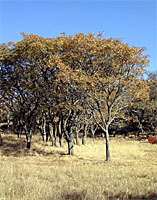View crop
View crop Data sheet EcoPortBurkea africana
 |
|
| Notes |
|---|
| DESCRIPTION: It is often a graceful, deciduous tree reaching 4-8 in height, but it can also be a low shrub or in Malawi a tall tree reaching up to 21 m. It typically with a single trunk and a flat-canopy but sometimes with a rounded crown. The leaves are from 38-60 cm long, bipinnately compound with about 2-4 pairs of opposite or slightly alternate pinnae. USE: The gum is edible. The roots, pods and bark are used for tanning. Wood used for carpentry and as firewood. The flowers are a good source of honey. The bark and gum is used medicinally and the tree is used as an ornamental. GROWING PERIOD: Perennial. COMMON NAMES: Wild seringa, Burkea, Maco, Wildesering. FURTHER INF: Found in sandy soils in savanna vegetation, particularly open bushveld, rocky habitats. It shows a strong preference for deep, loose, sandy soil. Most characteristic of hot, low-lying areas. Found from northern provinces of South Africa and Mozambique in the south, westwards through Botswana to northern Namibia and then northwards to Ethiopia and Nigeria. | Sources |
| Grassland Index |